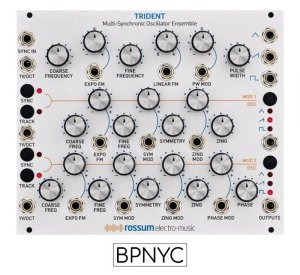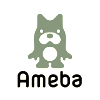Rossum Electro-Music TRITON (旧名TRIDENT)マルチシンクロニック オシレーターアンサンブル 次回入荷分
The latest brainchild of synth pioneer Dave Rossum, TRITON (formerly known as TRIDENT) is a 100% analog, triple oscillator module that opens up a universe of dynamic timbral textures.
At its most basic level, TRITON is three precision audio VCOs, each sporting a unique variety of control voltage inputs.
The main or “Carrier” oscillator provides its three waveforms simultaneously. The two Modulation Oscillators each have a single output and a waveform selector. The Modulation Oscillators also have a voltage controlled Symmetry parameter which varies the duty cycle of the triangle wave output from sawtooth to triangle back to time reversed sawtooth, and also varies the sawtooth output to have an upward or downward kink in the middle, as well as controlling pulse width when the pulse waveform is selected.
And while each oscillator can be used independently if desired, it’s when they’re combined into a synchronous ensemble that the real sonic magic happens.
That magic is what we call Zing Modulation. Each of the Modulation Oscillators can modulate each of the Carrier outputs in an amount controlled by the Zing parameter. Zing Modulation is mathematically akin to ring modulation, but due to the synchronization of the oscillators (when an oscillator’s Sync button is on), the aharmonic sum and difference sidetones of ring modulation transform into complex but purely harmonic overtone spectra, which vary dynamically and dramatically with the frequency and waveshape modulations of the modulation oscillators. Each change in the Modulation Oscillator parameters – Frequency, Symmetry, Waveshape, Zing, and (in the case of Modulation Oscillator 2) Phase – will have a different effect on the timbre of each of the three Carrier waveshape outputs.
When the modulation oscillators are set to track the carrier oscillator, the waveshape will remain constant as the carrier frequency changes. In this case the overtone structure is determined by the settings and CV modulations of the modulation oscillators. If instead the modulation oscillators do not track the carrier, some of the overtone structure will vary relative to the carrier frequency.
What all this means is that whether you take advantage of TRITON’s unique synchronous modulation capabilities (which you, of course, should), or just treat it as three superb, wide-range analog oscillators, TRITON offers a vast variety of dramatic sonic textures.
TRITON features include:
– Three precision analog oscillators with dedicated 1V/Octave inputs and coarse control ranges of 20Hz to 20kHz and modulated ranges of 0.01Hz to 25 kHz.
– Main Carrier oscillator with simultaneous triangle, sawtooth and pulse waveforms, with exponential and linear frequency modulation and pulse width modulation.
– Main Carrier oscillator hard sync input
– Modulation Oscillator 1 with selectable triangle, sawtooth and pulse waveforms with exponential frequency modulation, variable symmetry and symmetry modulation, and variable Zing level and Zing level modulation.
– Modulation Oscillator 2 with selectable triangle, sawtooth and pulse waveforms with exponential frequency modulation, variable symmetry and symmetry modulation, variable Zing level and Zing level modulation, and variable phase and phase modulation.
– Both Modulation Oscillators with independently selectable options to sync to the Main Carrier oscillator and track the Main Carrier oscillator
– TRITON, like all Rossum Electro-Music modules, features solid construction, with thick aluminum panels, solid aluminum knobs, and quality components throughout.
TRITON is 30HP wide and 25mm deep.
Power requirements (max): 290mA +12V, 270mA -12V. Reverse polarity protected.
At its most basic level, TRITON is three precision audio VCOs, each sporting a unique variety of control voltage inputs.
The main or “Carrier” oscillator provides its three waveforms simultaneously. The two Modulation Oscillators each have a single output and a waveform selector. The Modulation Oscillators also have a voltage controlled Symmetry parameter which varies the duty cycle of the triangle wave output from sawtooth to triangle back to time reversed sawtooth, and also varies the sawtooth output to have an upward or downward kink in the middle, as well as controlling pulse width when the pulse waveform is selected.
And while each oscillator can be used independently if desired, it’s when they’re combined into a synchronous ensemble that the real sonic magic happens.
That magic is what we call Zing Modulation. Each of the Modulation Oscillators can modulate each of the Carrier outputs in an amount controlled by the Zing parameter. Zing Modulation is mathematically akin to ring modulation, but due to the synchronization of the oscillators (when an oscillator’s Sync button is on), the aharmonic sum and difference sidetones of ring modulation transform into complex but purely harmonic overtone spectra, which vary dynamically and dramatically with the frequency and waveshape modulations of the modulation oscillators. Each change in the Modulation Oscillator parameters – Frequency, Symmetry, Waveshape, Zing, and (in the case of Modulation Oscillator 2) Phase – will have a different effect on the timbre of each of the three Carrier waveshape outputs.
When the modulation oscillators are set to track the carrier oscillator, the waveshape will remain constant as the carrier frequency changes. In this case the overtone structure is determined by the settings and CV modulations of the modulation oscillators. If instead the modulation oscillators do not track the carrier, some of the overtone structure will vary relative to the carrier frequency.
What all this means is that whether you take advantage of TRITON’s unique synchronous modulation capabilities (which you, of course, should), or just treat it as three superb, wide-range analog oscillators, TRITON offers a vast variety of dramatic sonic textures.
TRITON features include:
– Three precision analog oscillators with dedicated 1V/Octave inputs and coarse control ranges of 20Hz to 20kHz and modulated ranges of 0.01Hz to 25 kHz.
– Main Carrier oscillator with simultaneous triangle, sawtooth and pulse waveforms, with exponential and linear frequency modulation and pulse width modulation.
– Main Carrier oscillator hard sync input
– Modulation Oscillator 1 with selectable triangle, sawtooth and pulse waveforms with exponential frequency modulation, variable symmetry and symmetry modulation, and variable Zing level and Zing level modulation.
– Modulation Oscillator 2 with selectable triangle, sawtooth and pulse waveforms with exponential frequency modulation, variable symmetry and symmetry modulation, variable Zing level and Zing level modulation, and variable phase and phase modulation.
– Both Modulation Oscillators with independently selectable options to sync to the Main Carrier oscillator and track the Main Carrier oscillator
– TRITON, like all Rossum Electro-Music modules, features solid construction, with thick aluminum panels, solid aluminum knobs, and quality components throughout.
TRITON is 30HP wide and 25mm deep.
Power requirements (max): 290mA +12V, 270mA -12V. Reverse polarity protected.
Rossum Electro-Music TRITON (旧名TRIDENT)マルチシンクロニック オシレーターアンサンブル 次回入荷分


販売価格: 136,206円 [通常販売価格: 144,900円]
重さ: 2lb





